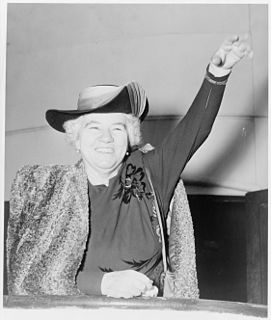
Sister Elizabeth Kenny was a self-trained Australian bush nurse, who developed an approach to treating poliomyelitis that was controversial at the time. Her method, promoted internationally while working in Australia, Europe and the United States, differed from the conventional one of placing affected limbs in plaster casts. Instead she applied hot compresses, followed by passive movement of the areas to reduce what she called "spasm". Her principles of muscle rehabilitation became the foundation of physical therapy or physiotherapy in such cases. Her life story was told in a 1946 film, Sister Kenny, portrayed by Rosalind Russell, who was nominated for the Academy Award for Best Actress for her performance.

Lady Bowen Hospital is a heritage-listed former maternity hospital at 497-535 Wickham Terrace, Spring Hill, City of Brisbane, Queensland, Australia. It was designed by John H. Buckeridge and built from 1889 to 1890 by John Quinn. It was also known as Brisbane Lying-In Hospital, Lady Bowen Hostel, and Anzac House & Club. It was added to the Queensland Heritage Register on 23 April 1999.

Baillie Henderson Hospital is a heritage-listed psychiatric hospital at 1 Hogg Street, Cranley, Toowoomba, Toowoomba Region, Queensland, Australia. It was built from 1888 to 1919. It is also known as Toowoomba Hospital for the Insane, Toowoomba Lunatic Asylum, and Toowoomba Mental Hospital. It was added to the Queensland Heritage Register on 27 September 1999.
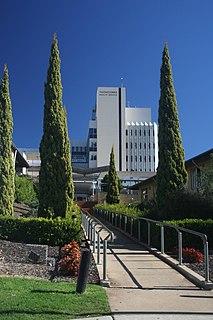
Toowoomba Hospital is a heritage-listed hospital at Pechey Street, Toowoomba, Toowoomba Region, Queensland, Australia. It was built from c. 1880 to c. 1927. It is also known as Toowoomba Base Hospital. It was added to the Queensland Heritage Register on 28 July 2000.
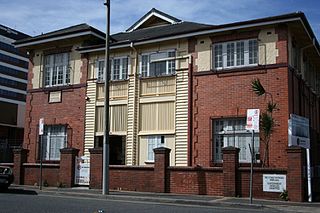
Fortitude Valley Child Health Centre is a heritage-listed clinic at 112 Alfred Street, Fortitude Valley, Queensland, Australia. It was designed by Cecil James Virgo. It is also known as Fortitude Valley Baby Clinic & Nurse Training Centre. It was added to the Queensland Heritage Register on 12 August 2011.

The Royal Brisbane Hospital Nurses' Homes are heritage-listed accommodation for nurses at the Royal Brisbane Hospital, Herston Road, Herston, City of Brisbane, Queensland, Australia. It was built from 1896 to 1939. It includes the Lady Lamington Nurses' Home and Nurses' Homes Blocks 1 & 2. It was added to the Queensland Heritage Register on 21 October 1992.

Rosemount Hospital is a heritage-listed hospital at 189 Lutwyche Road, Windsor, City of Brisbane, Queensland, Australia. It was built from 1850s to 1940s. It is also known as Rosemount, Rosemount Military Hospital, and Rosemount Repatriation General Hospital. It was added to the Queensland Heritage Register on 24 September 1999.
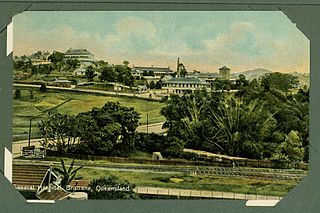
Brisbane General Hospital Precinct is a heritage-listed hospital precinct at 40 Bowen Bridge Road, Herston, City of Brisbane, Queensland, Australia. It was built from 1875 to 1941. It includes six historic buildings associated with the Royal Brisbane and Women's Hospital and the former Royal Children's Hospital, as well as aspects of their grounds and landscaping. It was added to the Queensland Heritage Register on 28 March 2003. A number of buildings in the precinct, in particular the Lady Lamington Nurses Home, will be redeveloped as part of the Herston Quarter development.

Rockhampton Hospital is the largest major hospital in Central Queensland, Australia. Operated by Queensland Health as a public hospital, the hospital offers a wide range of medical services to a population of about 230,000 throughout the Rockhampton, Gladstone, the Capricorn Coast and Emerald communities.

Masel Residence is a heritage-listed detached house at 98 High Street, Stanthorpe, Southern Downs Region, Queensland, Australia. It was designed by Charles William Thomas Fulton and built from 1937 to 1938 by Kell & Rigby. It is also known as Diamond Residence. It was added to the Queensland Heritage Register on 7 February 2005.

Maryborough Base Hospital is a heritage-listed hospital at Walker Street, Maryborough, Fraser Coast Region, Queensland, Australia. It was designed by Queensland Colonial Architect John James Clark and built from 1887 by Robert Taylor. It is also known as Maryborough General Hospital. It was added to the Queensland Heritage Register on 2 February 1998.

Rockhampton Town Hall is a heritage-listed town hall at 232 Bolsover Street, Rockhampton City, Rockhampton, Rockhampton Region, Queensland, Australia. It was designed by Hockings & Palmer and built from 1939 to 1941 by John Hutchinson of J. Hutchinson & Sons. It is also known as Rockhampton City Hall and Rockhampton Council Chambers. It was added to the Queensland Heritage Register on 29 April 2003.
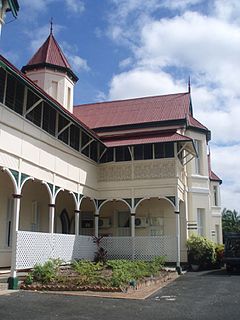
Rockhampton Girls Grammar School is a heritage-listed private school at 155 Agnes Street, The Range, Rockhampton, Rockhampton Region, Queensland, Australia. It was designed by Edwin Morton Hockings and built in 1890 by Moir Cousins and Co. It was added to the Queensland Heritage Register on 20 October 2000.

Rudd Residence is a heritage-listed villa at 248 Agnes Street, The Range, Rockhampton, Rockhampton Region, Queensland, Australia. It was built from c. 1923. It is also known as Mitchell Residence. It was added to the Queensland Heritage Register on 22 October 1999.

The Range Convent and High School is a heritage-listed private school at 263 Agnes Street, The Range, Rockhampton, Rockhampton Region, Queensland, Australia. It was built from c.1880s to 1930s. It is also known as Our Lady of Good Counsel Convent and School and The Catholic College Residential. It was added to the Queensland Heritage Register on 21 October 1992.

Trustee Chambers is a heritage-listed former house and subsequent commercial building at 170 Quay Street, Rockhampton, Rockhampton Region, Queensland, Australia. It was designed by architect John William Wilson and built from 1876 to 1877. It is also known as Residence of Dr William Callaghan and River Chambers. It was added to the Queensland Heritage Register on 21 October 1992.

Kenmore House is a heritage-listed mansion at 31 Ward Street, The Range, Rockhampton, Rockhampton Region, Queensland, Australia. The design is attributed to James Flint and it was built from c. 1894 onwards. It is also known as Mater Misericordiae Hospital, Pinehurst and The Mansion. It was added to the Queensland Heritage Register on 21 October 1992.

Proserpine Hospital is a heritage-listed public hospital at Herbert Street, Proserpine, Whitsunday Region, Queensland, Australia. It was designed by Hill & Taylor and built from 1939 to 1940 by W C Kynaston. It was added to the Queensland Heritage Register on 23 February 2001.

Townsville Central State School is a heritage-listed state school and former prison at 4-6 Warburton Street, North Ward, City of Townsville, Queensland, Australia. It was designed by Francis Drummond Greville Stanley and built from 1877 to 1880 by J Rooney. It is also known as the former Townsville Gaol and Residence of the Police Inspector. It was added to the Queensland Heritage Register on 1 October 2003.

Rockhampton Grammar School Buildings are a heritage-listed group private school buildings at Archer Street, The Range, Rockhampton, Rockhampton Region, Queensland, Australia. They were built from 1880 to 1951. It was added to the Queensland Heritage Register on 21 October 1992.























